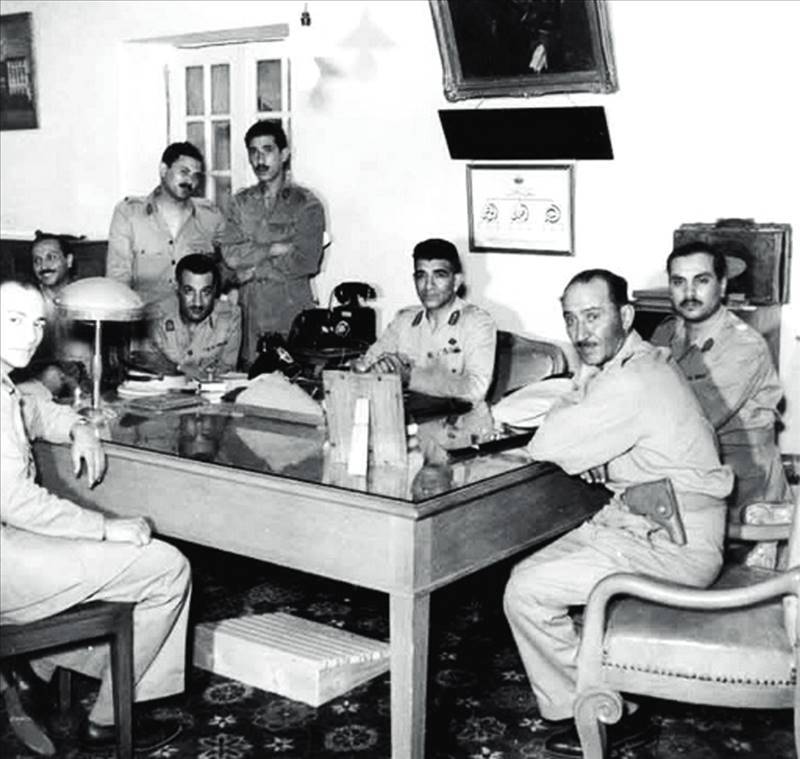
Members of the Free Officers huddled in a meeting after the coup d’état in Egypt in 1952. Earlier, the Free Officers, a nationalistic military group led by Colonel Gamal Abdel Nasser, engineered a coup that overthrew King Farouk I, ending the monarchy and bringing Nasser to power. From left to right: Zakaria Mohieddin, Abdel Latif Boghdadi, Kamel el-Din Hussein, Gamal Abdel Nasser (seated), Abdel Hakim Amer, Muhammad Naguib, Youssef Seddik and Ahmed Shawki.
While the Free Officers planned to overthrow the monarchy on 2–3 August, they decided to make their move earlier after their official leader Muhammad Naguib gained knowledge, leaked from the Egyptian cabinet on July 19 that King Farouk acquired a list of the dissenting officers and was set to arrest them. The officers thus decided to launch a pre-emptive strike and after finalizing their plans in meeting at the home of Khaled Mohieddin, they began their coup on the night of July 22. Mohieddin stayed in his home and Anwar Sadat went to the cinema.
Meanwhile, the chairman of the Free Officers, Gamal Abdel Nasser, contacted the Muslim Brotherhood and the communist Democratic Movement for National Liberation to assure their support. On the morning of July 23, he and Abdel Hakim Amer left Mohieddin’s home in civilian clothes and drove around Cairo in Nasser’s automobile to collect men to arrest key royalist commanders before they reached their barracks and gain control over their soldiers. As they approached the el-Qoba Bridge, an artillery unit led by Youssef Seddik met with them before he led his battalion to take control of the Military General Headquarters to arrest the royalist army chief of staff, Hussein Sirri Amer and all the other commanders who were present in the building. At 6:00 am the Free Officers air force units began circling Cairo’s skies.
At 7:30 a.m, a broadcasting station issued the first communiqué of the coup d’état in the name of General Naguib to the Egyptian people. It attempted to justify the coup, which was also known as the “Blessed Movement.” The person reading the message was Free Officer and future president of Egypt Anwar Sadat. The coup was conducted by less than a hundred officers - almost all of which were drawn from junior ranks — and prompted scenes of celebration in the streets by cheering crowds.
While the Free Officers planned to overthrow the monarchy on 2–3 August, they decided to make their move earlier after their official leader Muhammad Naguib gained knowledge, leaked from the Egyptian cabinet on July 19 that King Farouk acquired a list of the dissenting officers and was set to arrest them. The officers thus decided to launch a pre-emptive strike and after finalizing their plans in meeting at the home of Khaled Mohieddin, they began their coup on the night of July 22. Mohieddin stayed in his home and Anwar Sadat went to the cinema.
Meanwhile, the chairman of the Free Officers, Gamal Abdel Nasser, contacted the Muslim Brotherhood and the communist Democratic Movement for National Liberation to assure their support. On the morning of July 23, he and Abdel Hakim Amer left Mohieddin’s home in civilian clothes and drove around Cairo in Nasser’s automobile to collect men to arrest key royalist commanders before they reached their barracks and gain control over their soldiers. As they approached the el-Qoba Bridge, an artillery unit led by Youssef Seddik met with them before he led his battalion to take control of the Military General Headquarters to arrest the royalist army chief of staff, Hussein Sirri Amer and all the other commanders who were present in the building. At 6:00 am the Free Officers air force units began circling Cairo’s skies.
At 7:30 a.m, a broadcasting station issued the first communiqué of the coup d’état in the name of General Naguib to the Egyptian people. It attempted to justify the coup, which was also known as the “Blessed Movement.” The person reading the message was Free Officer and future president of Egypt Anwar Sadat. The coup was conducted by less than a hundred officers - almost all of which were drawn from junior ranks — and prompted scenes of celebration in the streets by cheering crowds.

